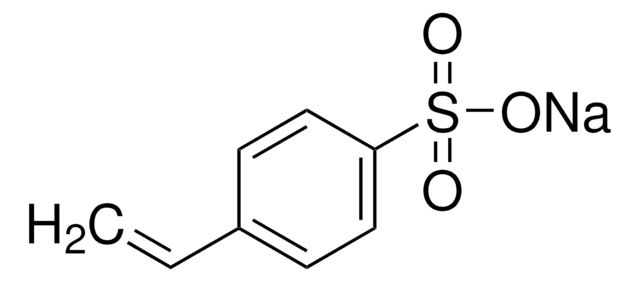251658
3-Sulfopropyl methacrylate potassium salt
98%
Synonym(s):
Methacrylic Acid 3-Sulfopropyl Ester Potassium Salt
Sign Into View Organizational & Contract Pricing
All Photos(1)
About This Item
Linear Formula:
H2C=C(CH3)CO2(CH2)3SO3K
CAS Number:
Molecular Weight:
246.32
EC Number:
MDL number:
UNSPSC Code:
12162002
PubChem Substance ID:
NACRES:
NA.23
Recommended Products
Assay
98%
form
solid
mp
295 °C (dec.) (lit.)
SMILES string
[K+].CC(=C)C(=O)OCCCS([O-])(=O)=O
InChI
1S/C7H12O5S.K/c1-6(2)7(8)12-4-3-5-13(9,10)11;/h1,3-5H2,2H3,(H,9,10,11);/q;+1/p-1
InChI key
PNOXUQIZPBURMT-UHFFFAOYSA-M
Application
- Antifouling and flux enhancement of reverse osmosis membrane by grafting poly (3-sulfopropyl methacrylate) brushes: This study explores the enhancement of antifouling properties in reverse osmosis membranes through grafting, addressing significant issues in membrane-based water treatment technologies (Mushtaq et al., 2021).
- Effect of cation alkyl chain length on 3-sulfopropylmethacrylate-based draw solutes having lower critical solution temperature: This article explores the physicochemical properties of ionic liquids derived from 3-sulfopropyl methacrylate, important for developing new materials with specific thermal and solubility properties (Moon et al., 2023).
- Transpicuous-cum-fouling resistant copolymers of 3-sulfopropyl methacrylate and methyl methacrylate for optronics applications in aquatic medium: Discusses the development of copolymers for optical applications, particularly in environments where fouling resistance is crucial, relevant for material science (Mushtaq et al., 2020).
- A general approach for construction of asymmetric modification membranes for gated flow nanochannels: This research introduces a method for modifying membranes with nanochannels using 3-sulfopropyl methacrylate, important for creating selective transport pathways in sensor and separation technologies (Ma et al., 2014).
Signal Word
Warning
Hazard Statements
Precautionary Statements
Hazard Classifications
Skin Sens. 1A
Storage Class Code
11 - Combustible Solids
WGK
WGK 1
Flash Point(F)
Not applicable
Flash Point(C)
Not applicable
Personal Protective Equipment
dust mask type N95 (US), Eyeshields, Gloves
Choose from one of the most recent versions:
Already Own This Product?
Find documentation for the products that you have recently purchased in the Document Library.
Customers Also Viewed
Ahmed Salama
International journal of biological macromolecules, 106, 940-946 (2017-08-24)
A novel superadsorbent anionic hydrogel was synthesized by grafting of poly (3-sulfopropyl methacrylate), P(SPMA), onto carboxymethyl cellulose (CMC). CMC-g-P(SPMA) superadsorbent hydrogel was applied as an efficient and sustainable adsorbent to remove methylene blue (MB) from waste water. Batch adsorption experiments
Yu Zhang et al.
Biomaterials science, 5(12), 2493-2500 (2017-11-09)
The current paper reports a novel model of a marine antibiofouling surface based on polymer brushes on a wrinkled silicone elastomer. Polymer brushes (POEGMA and PSPMA) were grafted via surface-initiated atom transfer radical polymerization (SI-ATRP). Successful grafting was verified with
Antoine Venault et al.
Colloids and surfaces. B, Biointerfaces, 151, 372-383 (2017-01-08)
This work discusses the impact of the charge bias and the hydrophilicity on the human blood compatibility of pseudozwitterionic biomaterial gels. Four series of hydrogels were prepared, all containing negatively-charged 3-sulfopropyl methacrylate (SA), and either acrylamide, N-isopropylacrylamide, 2-dimethylaminoethyl methacrylate (DMAEMA)
Daniel Gonzalez-Carter et al.
Nanoscale, 11(45), 22054-22069 (2019-11-14)
Nanoparticles capable of penetrating the blood-brain barrier (BBB) will greatly advance the delivery of therapies against brain disorders. Carbon nanotubes hold great potential as delivery vehicles due to their high aspect-ratio and cell-penetrating ability. Studies have shown multiwalled carbon nanotubes
Armin Eraghi Kazzaz et al.
Journal of colloid and interface science, 561, 231-243 (2019-12-13)
Amphoteric polymers have tremendous applications in colloidal systems. Despite the enormous availability of lignin, the generation of amphoteric lignin polymer has yet to be discovered. In this work, amphoteric lignin was synthesized in an industrially attractive aqueous system via integrating
Our team of scientists has experience in all areas of research including Life Science, Material Science, Chemical Synthesis, Chromatography, Analytical and many others.
Contact Technical Service![[2-(Methacryloyloxy)ethyl]trimethylammonium chloride solution 75 wt. % in H2O](/deepweb/assets/sigmaaldrich/product/structures/316/612/66b0f4cf-d060-427d-b4f5-e8fab3e5cffe/640/66b0f4cf-d060-427d-b4f5-e8fab3e5cffe.png)
![[2-(Methacryloyloxy)ethyl]dimethyl-(3-sulfopropyl)ammonium hydroxide 95%](/deepweb/assets/sigmaaldrich/product/structures/217/219/73c91e1c-0ee4-4b3d-bead-a6dc3d09d1da/640/73c91e1c-0ee4-4b3d-bead-a6dc3d09d1da.png)



![[2-(Acryloyloxy)ethyl]trimethylammonium chloride solution 80 wt. % in H2O, contains 600 ppm monomethyl ether hydroquinone as inhibitor](/deepweb/assets/sigmaaldrich/product/structures/393/326/f7e19585-5431-4220-81b5-f458de6d63d0/640/f7e19585-5431-4220-81b5-f458de6d63d0.png)


![[3-(Methacryloylamino)propyl]trimethylammonium chloride solution 50 wt. % in H2O](/deepweb/assets/sigmaaldrich/product/structures/189/736/089bc8ae-2a98-416d-9f9a-a0a510b6b828/640/089bc8ae-2a98-416d-9f9a-a0a510b6b828.png)



